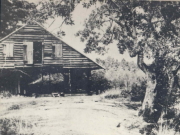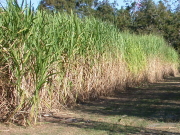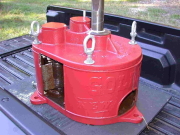Power Requirement for Mechanizing a Vertical Animal-Powered Cane Mill
There are, of course, many effective drive train designs for powering a vertical cane mill that originally was rotated by an animal connected to a lever. Many of these designs are shown on the Operations Page where the ingenuity of syrup makers is demonstrated. Often these designs arise from reverse engineering and utilize components readily at hand, such as open gears from a discarded hay press or the differential from a small truck or a transmission from a school bus or a right-angle converter from a peanut lifter. Obviously, a calculator cannot match the imagination of a determined syrup maker. This calculator, instead, applies to a single design as depicted, but it may offer perspective for other designs. In brief, the following principles for this design are offered: (1) A chain drive, not a belt drive, should be used with a right-angle speed reducer, because it puts less overhang load on the mill than a belt drive does. (2) The chain drive ratio should be as high as practical (ca. 6:1) because a chain drive is efficient and permits a smaller, more efficient, and less expensive speed reducer with a lower output torque. (3) The sprockets for the chain drive should be mounted close to the driver and driven unit, unless the shafts are supported by pillar blocks, to minimize the overhang load. (4) The chain should be large, e.g., 100 ANSI.
This page is provided for educational and entertainment purposes.
No liability is assumed.
Thanks to Ken Christison, Charles Deese, Hiram Gibbard, and Ken Womble for contributions to this page.





